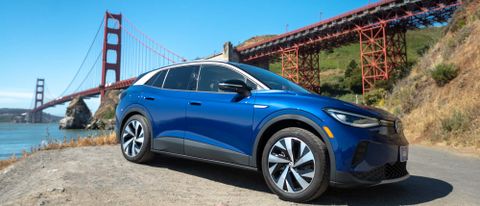Tom's Guide Verdict
Volkswagen’s first purpose-built EV in the US eschews performance in favor of being a daily driver. Other than a laggy infotainment screen, the ID.4 hits all the needs of the average consumer.
Pros
- +
Comfortable ride
- +
Up to 260-mile range
- +
Apple CarPlay and Android Auto included
- +
Three years of free Electrify America charging
Cons
- -
Not the most exciting EV
- -
Infotainment system is laggy
Why you can trust Tom's Guide
Release Date: Now for rear-wheel drive. Fourth-quarter of 2021 for all-wheel-drive
Price: Starts at $39,995 (MSRP); as tested $43,995
Power: single motor rear-wheel drive / dual motor all-wheel-drive
Horsepower: 201hp and 295 hp
Battery range: 240 to 260
Top speed: NA
Smarts: Wireless Apple CarPlay and Android Auto. ID Software
The EV world is littered with high-performance rides using speed to entice car shoppers to a world powered by ions instead of dead dinosaurs. The VW ID.4 — in its own stylish but subdued way — also wants to lure drivers to the quiet hum of driving an EV but instead of using impressive zero to 60 times, Volkswagen is instead appealing to the quickest growing market segment in the automotive world, the small SUV / crossover. The roomy and smooth driving ID.4 is better matched up against the Toyota Rav4 and Honda CRV than the Tesla Model Y and Ford Mustang Mach-E.
After over a week of driving the ID.4 First Edition trim, we found it to be a solid small SUV contender when pitted against gas-powered counterparts. The four-door, rear-wheel-drive vehicle offers 250 miles of range; in our mixed-use tests on the highway, surface streets, and along curvy mountain passes, the vehicle typically matched or surpassed that range number unless we were pushing the vehicles during speed tests.
We found driving to be smooth, the seats to be comfortable and the vehicle’s driver assistance features to be on par with other offerings in this price range. Where the vehicle falls flat is its laggy infotainment system housed in a 10- or 12-inch infotainment display. Fortunately, Apple CarPlay and Android Auto are both supported. Overall, this is one of the best electric cars for those looking for a practical small SUV.
Volkswagen ID.4 review: Release date, pricing and trim levels
The 2021 Volkswagen ID.4 is available right now as a rear-wheel-drive vehicle, and it’s available in two trim levels. The entry-level Pro and limited availability 1st Edition offer the same single motor powertrain outputting 201 horsepower and 229 pound-feet of torque. The base-level Pro starts at $39,995, has a range of 260 miles and ships with a 10-inch infotainment display, heated seats, wireless CarPlay and Android Auto, and the vehicle’s advanced driver assistance features.
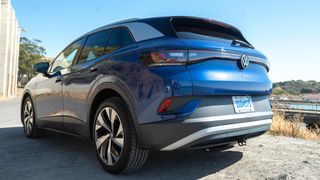
For $43,995, the 1st Edition builds upon that list with special badging 20” alloy wheels, premium LED lights, and a glass roof.
Available later this year, the all-wheel-drive (AWD) variants will be available also in two trim levels, the Pro and Pro S. Both vehicles offer up 295 horsepower. The AWD Pro starts at $43,675 and likely has the same interior and 10-inch display as its rear-wheel-drive counterpart. The Pro S starts at $48,175 and with the optional Gradient package adds 20-inch alloy wheels. The range for the vehicles is 249 miles and 240 miles respectively. The AWD ID.4 versions are available for purchase now but won’t be shipped until the fourth quarter of 2021.

The delivery charge on all the ID.4 variants is $1,195 and all are eligible for the $7,500 federal tas credit. That eligibility gives the ID.4 a competitive edge against offerings from Tesla and GM. Vehicles from both automakers no longer qualify for the federal credit.
Volkswagen ID.4 review: Range, battery and charging
One benefit of Volkswagen owning the Electrify America network is that all ID.4 vehicles come with three years of free charging at their stations.
In a mixed driving environment with the ID.4 for more than a week, the 1st Edition’s 250 miles of range was usually met or even surpassed, although only by a few miles based on our calculations. Days when the vehicle spent most of its time traveling at 70 miles-per-hour and above that number dropped as you would expect from an EV. Of course, on days when the vehicle was being tested with multiple speed runs and hard-driving, the range also took a hit.
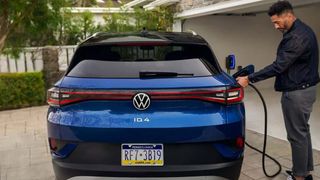
All ID.4’s are equipped with an 82 kWh battery pack and of that, 77 kWh are available to the vehicle at any time. That discrepancy is there to counteract battery degradation eating into the vehicle’s range. All batteries degrade, that’s just how batteries work. But the ID.4 and other EV’s that set aside battery capacity to counter that issue are likely to have the same range for years.
Charging and finding chargers has become less of an issue as more stations are being built. We tested our vehicle in the San Francisco Bay Area where charging stations are likely more plentiful than in other parts of the country. That said, the vehicle’s navigation system made it simple to find charging stations near us while driving.

The ID.4 supports DC-fast charging at speeds up to 125 kW. Volkswagen says that can top up the battery from 5% to 80% in about 38 minutes, which is in line with our testing when we had access to a charging station that supported that speed.
One benefit of Volkswagen owning the Electrify America network is that all ID.4 vehicles come with three years of free charging at their stations. EV’s are already cheaper to run than gas vehicles when they’re charged at home, throw in free station charging and some owners might not even charge at home saving themselves a lot of money.
Volkswagen ID.4 review: Interior and cargo space
If you spend hours a day in a vehicle, the ID.4’s spacious and airy interior will at least give you some interior breathing room. The front seats are comfortable enough for long road trips with enough head and legroom for even the tallest drivers. The rear seats are a bit cramped for tall passengers while you could put three grown adults in the back, during our tests, unless they’re thin, it’s best to make it a two adult affair back there.
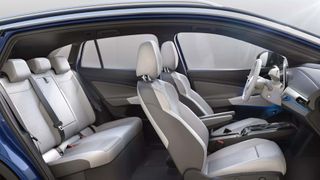
Cargo space is plentiful with 30.3 cubic feet of space behind the second row. During our tests we fit 14 grocery bags behind the second row. In another test we placed two large suitcases and two smaller carry-on suitcases behind the second row without any issue.
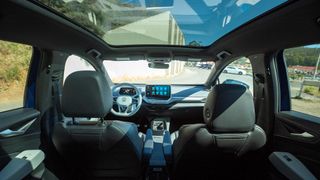
For those needing more room, with the rear seats folded down, the cargo space more than doubles to 64.2 cubic square feet of space. Enough for a large run to Costco.

Our review unit had a fixed glass roof, which included a shade that could be deployed to cut out the sun’s harsh rays. We’ve driven vehicles with glass roofs without a sunshade and most of the time it’s fine, but there are instances where the glare and heat can be annoying. The shade is a welcome edition.
Volkswagen ID.4 review: Tech and safety features
The ID.4 continues the tradition of electric vehicles offering up tech-heavy features by delivering a dashboard that’s taken some design cues from the Apple Store. Keyless entry and wireless smartphone connections are standard. Plus, like the Polestar 2 and Tesla vehicles, the ID.4 turns on when the driver sits down.
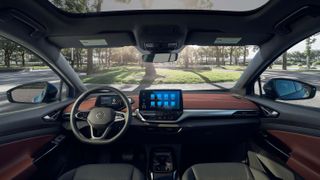
The issue isn’t the infotainment features but the latency of the system. In some cases, I had to tap items multiple times.
Fortunately, the butt-powered ignition system is supplemented with an actual on and off button for those times when the car needs to stay on when the driver is out of the driver’s seat.
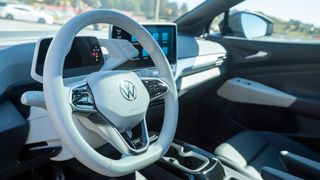
Behind the wheel and attached to the steering column is the 5.3-inch ID Cockpit dash cluster. The digital display eschews the recent trend of adding more and more information below the windshield and instead only shares the most relevant information, including speed, state of charge, navigation and driver assistance status.
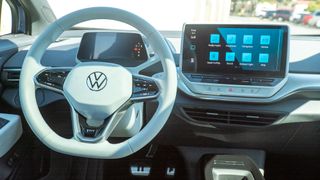
In the center of the dash sits a 10- or 12-inch display that houses the vehicle’s infotainment system. The features of the system include all the expected settings and status information in a familiar grid layout with a customizable home screen that displays multiple pieces of information at once like media, navigation and phone. The issue isn’t the features but rather the latency of the system during use. In some cases, I had to tap items multiple times in order to make a selection, and swiping between screens also required multiple tries before there was any success.
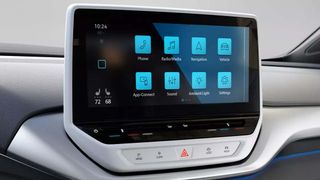
While laggy, the Volkswagen ID Software infotainment system does offer up the expected suite of features for an EV. The iteration of Volkswagen’s infotainment system first appeared in the smaller ID.3 that’s available in Europe and was adjusted for use in the United States for the ID.4. Volkswagen has experienced some initial issues with the software in its new electric vehicles. These growing pains are to be expected, but it doesn’t take the sting off buying a $40,00o vehicle and having the infotainment system take more than one swipe to switch screens.
Fortunately, over-the-air updates are available for the ID.4 and hopefully, these latency issues will be resolved at some point in the future. In fact, after returning the vehicle and right before this article was published, Volkswagen issued its first over-the-air update for the ID.3 with the ID.4 expected to receive the update soon.
Wireless CarPlay and Android Auto are standard as well as a wireless charging pad in the center console. Each vehicle is also outfitted with two USB-C ports in the front and two USB-C charge ports in the back.
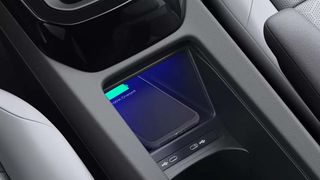
The ID.4 comes standard with navigation that includes the ability to find nearby charging stations. Helpful during road trips.
Safety and drivers assistance features include adaptive cruise control, lane keep assistant, rear traffic alerts while baking up and autonomous emergency braking in addition to the usual blind-spot monitoring, rear backup camera, and forward-collision warning. All of which worked as expected.
Volkswagen ID.4 review: The drive
After more than a week and hundreds of miles behind the wheel of the ID.4, it's safe to say that Volkswagen did indeed build a proper competitor to the plethora of small SUVs on the market that run on gas. While the rear-wheel-drive drivetrain might seem to lend itself to performance driving, the 201 horsepower 1st Edition we drove was more about grocery runs than quarter-mile runs.
On highways and surface streets, the ID.4 is composed and capable of offering up a smooth ride without any fuss. At high speeds, the cabin was still quieter than gas competitors and the overall experience of the driver and passengers was pleasant.
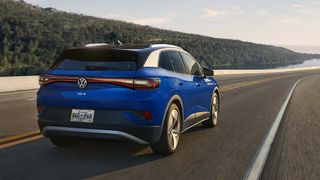
On curvy backroads that haven’t seen a construction crew in likely a decade, the vehicle’s low center of gravity gave it a slightly sporty feel. But only slightly. Body roll was kept in check by the heft of the battery pack under the passenger compartment, but not enough to give you the experience of something like Volkswagen’s Golf GTI. Unlike the Mach-E and Model Y, the 1st Edition ID.4 is not going to wow anyone with its prowess around corners.
While mild and moderate bumps were easily swallowed up by the ID.4 while on the highway and surface streets, deeper ruts in the road combined with a curve exposed the limits of the suspension. While technically an SUV, like most vehicles in this space, off-roading should be kept to maintained dirt roads with moderate bumps, holes and ruts.
The AWD ID.4 was unavailable during our tests, but it’s likely that its additional power and increased traction would yield better results on backroads and offroading.
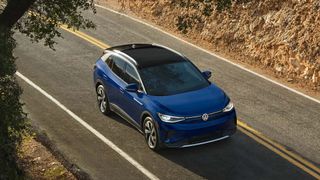
Acceleration benefits from the jot of instant EV torque, but this is not a vehicle built for spine-snapping EV drag races. The best use of the acceleration is off the line at stop lights at speeds up to 40 miles per hour. Yes, you’ll feel the jolt of the low-end torque but the acceleration is quickly tamed to something more at home around the neighborhood.
Braking does benefit from regenerative braking and with a turn of the shift knob to B, the vehicle’s regenerative braking system is placed in its high setting. Unfortunately, that setting doesn’t offer the one-pedal driving feature found in the Chevy Bolt and Nissan Leaf that brings the vehicle to a stop when the driver lifts off the accelerator. The brakes themselves are adequate for daily driving both with just the driver in the vehicles and with four passengers and the back of the vehicle filled with cargo. During more spirited driving, the brakes could use an additional 10 to 15% of stopping power, but again, the ID.4 isn’t built for this type of driving.
Steering weighted appropriately for an SUV so not much to be excited about there. Yet, we were surprised at the smaller-than-anticipated turning circle of the ID.4, which made u-turns on single-lane roads a snap. It also was a benefit in parking lots where squeezing into tight parking spots and having to navigate around corners with large trucks in the other lane can be a challenge.
Volkswagen ID.4 review: Navigation and driver assistance features
The ID.4’s navigation has the benefit of the vehicle’s voice assistant. We were able to set destinations without taking our hands off the wheel without much hassle. Turn-by-turn directions are available both in the center infotainment display and on the ID Cockpit dash cluster. The minimalist arrow system in the dash cluster worked well, and the ID Light (a light bar that runs underneath the length of the windshield) also offered up some help by flashing on either the left or right side of the vehicle as an indication of where to go as we came upon an intersection or interchange where we had to turn.
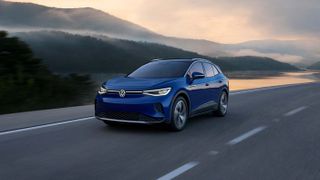
Volkswagen’s IQ.Drive driver assistance features are standard and include adaptive cruise control and lane-keep assist. These features are typically best used in traffic on the highway and fortunately (or unfortunately, for us), during our testing we were stuck in major gridlock that utilized the system over the course of a few hours.
Tracking the vehicle in front yielded no surprises, and the ID.4 slowed down appropriately during cut-ins (when a vehicle merges into your lane in front of you). When a slow-moving vehicle moved to another lane, the ID.4 accelerated a bit slower than we would have but not so much to impede traffic and anger the drivers behind us. At no point did we feel that the vehicle was approaching a stopped vehicle too quickly before applying the brakes an issue that happens often when a vehicle with adaptive cruise control suddenly encounters stop and go traffic.
Speaking of stop and go, the IQ.Drive system will follow the vehicle ahead of it after being stopped but only if it’s been stopped for less than three seconds. After the time period elapses you have to tap either Resume on the steering wheel or the accelerator. We wish that time period was a bit longer especially during extreme gridlock.
The vehicle did an adequate job tracking the lanes on the highway but this is where we remind you that these systems are just there to help, you still need to actually steer and pay attention while they are enabled.
Volkswagen ID.4 review: Verdict
Volkswagen hasn’t built a vehicle that’s meant to wow us. Instead, it’s aimed at the family or individual that needs a small SUV for errands, commuting, and just generally driving around town. It’s comfortable, offers plenty of space of a family or group of friends with room to spare for their stuff. It does all of this in a package that might not be exciting, but it’s capable and solidly built with enough range for 95% of what you’ll need it to do. Not every EV is going to break some acceleration record; some are built for regular life and that’s exactly where the ID.4 sits.
-
LarryWC2015 I have the 1st edition. The drivable range is about 160 miles. Even after having my car "serviced" the range didn't improve, in fact it is lower. VW says only charge to 80%, and charge as soon as it tells you at 20%. All city driving the car only gets 3.2 miles/kwh. Both local dealer and VW support also told me driving without AC would increase the range. This is my 3rd electric car. Worst one yet.Reply -
ThenCameTheLastDaysOfMay We’ve had our ID 4 for a little over a month. With one exception, I basically agree with the article’s review. That exception is just what Larry wrote. The range is terrible and no where near 250+. In fact, we’re averaging 153 miles per 80% charge. That would be wholly unacceptable if not for the fact that we get 3 years of free unlimited charging. That fact was the main reason we decided to go EV. That saves us over $4800 compared to what we were paying for gas on our Ford Explorer. Fortunately, we have the spare time for our 2 weekly trips to Electrify America. The car is primarily my wife’s daily driver and overall she is quite happy with it.Reply -
LarryWC2015 Thanks for posting this. In someway it's a relief to know that I'm not the only one with horrible mileage. I just don't know how anyone is get the 250 miles and some claim more.Reply -
EVone Reply
3.2miles/kWh = 246 Miles.LarryWC2015 said:I have the 1st edition. The drivable range is about 160 miles. Even after having my car "serviced" the range didn't improve, in fact it is lower. VW says only charge to 80%, and charge as soon as it tells you at 20%. All city driving the car only gets 3.2 miles/kwh. Both local dealer and VW support also told me driving without AC would increase the range. This is my 3rd electric car. Worst one yet. -
EVone Reply
Not sure how that's even possible unless you have a bad battery.ThenCameTheLastDaysOfMay said:We’ve had our ID 4 for a little over a month. With one exception, I basically agree with the article’s review. That exception is just what Larry wrote. The range is terrible and no where near 250+. In fact, we’re averaging 153 miles per 80% charge. That would be wholly unacceptable if not for the fact that we get 3 years of free unlimited charging. That fact was the main reason we decided to go EV. That saves us over $4800 compared to what we were paying for gas on our Ford Explorer. Fortunately, we have the spare time for our 2 weekly trips to Electrify America. The car is primarily my wife’s daily driver and overall she is quite happy with it.
Can you be more specific
Hwy Miles at 75? with AC on ? -
LarryWC2015 For me, no, all city driving. I use the "b" option with driving mode in econ. I never use max ac, i try to keep the ac at 74 with fan set on 2, but that doesnt really cool the car.Reply
I dont know what else to do. Dealer and VW won't do anything
Larry -
EVone Reply
I have test drove 3 different ID 4's that last one today.LarryWC2015 said:For me, no, all city driving. I use the "b" option with driving mode in econ. I never use max ac, i try to keep the ac at 74 with fan set on 2, but that doesnt really cool the car.
I dont know what else to do. Dealer and VW won't do anything
Larry
I got 3.5 Miles/kWh on Hwy 100 394 and hwy 169 on a 20 mile test drive.... 3.5 x 77= 269.5 with the AC set at 68 degrees F.
https://drive.google.com/file/d/1WNChuId1J-kDLBDTLvQQh-934k2Nowsy/view?usp=sharinghttps://drive.google.com/file/d/1WQrEXyoTOWc992CayfOgleg1fA2_-Cd5/view?usp=sharing -
EVone The Last one I drove in My City was a First Edition in City only and got 3.8miles.kWh =292.6 in the CityReply
I dont know what you are guys are doing but somethings not right.
Also YES Most evs you want not charge to 100% everyday especially at a Fast charger to help longevity of Battery.
That Said My Chevy Bolt with 97,000 miles on it still has 5.7 Kwh out of a 60kWh original battery. the Battery will be 5 years old in Dec and I drive Uber/Lyft and charge to %100 everyday
The ID 4 is Actually a 82kWh Battery..77 kWh is useable..so it has a 5kWh buffer...you cannot charge it to 100% (82kWh) so feel free IMO to charge it to100% of the 77kWh useable. -
LarryWC2015 How far have you driven it down to %? I get the recharge at 20%. From a full charge to 20% how many miles?Reply
I had my Bolt for 3 years then lease was up. 2022 wasn't out yet so went with ID.4. Big mistake. -
EVone Reply
No not a Mistake.. you just have a "bad one"..somethings not right. Either something electrical is running ,draining your main battery or you have a bad cell . 1 bad cell can bring down and entire Module within the Battery.LarryWC2015 said:How far have you driven it down to %? I get the recharge at 20%. From a full charge to 20% how many miles?
I had my Bolt for 3 years then lease was up. 2022 wasn't out yet so went with ID.4. Big mistake.
The ride in the ID 4 is amazing compared to the Bolt
